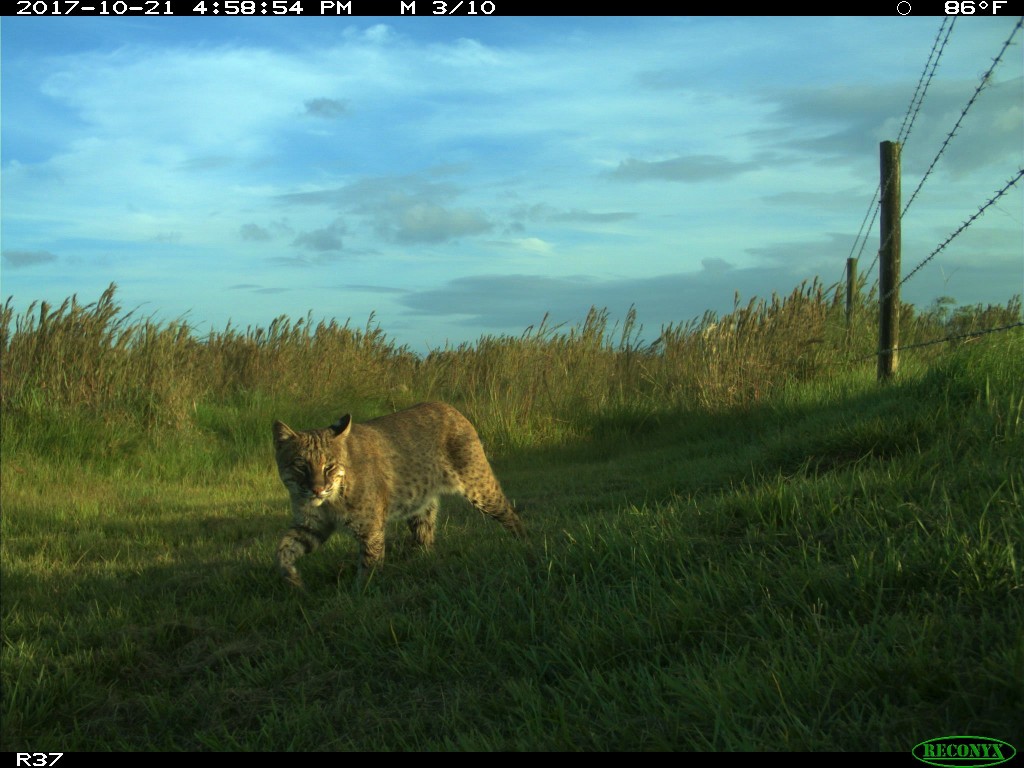
Authors: Joe Guthrie and Zach Forsburg
Some of what we know about the ecology of the Bobcat emerged from Archbold Biological Station and its history of mammal research. As the Station’s first Director of Research, Dr. James N. Layne conducted studies on many mammals known to Archbold, including a long-term study on the behavior and movement of Bobcats. Dr. Layne’s archive, which is maintained at Archbold and includes his published manuscripts, data, and decades of detailed field notes, is an invaluable source of information for those at work at Archbold today.
Archbold biologist Joe Guthrie is a frequent visitor to the Layne archive, where he says he searches for records of familiar animals like Bobcat and Florida Black Bear, as well as the less frequently seen animals, like Spotted Skunks. Guthrie oversees the Station’s Predator-Prey Program.
“Today we can use those records to design a sampling grid or track survey on the exact location where Dr. Layne and his team would have surveyed forty years ago. Even the anecdotal information, like a conversation he had with a neighboring landowner about River Otters, for example, can be a starting point for a project we might design,” says Guthrie.
Today Archbold scientists are utilizing a variety of new technologies to grow the organization’s body of research. The Predator-Prey Program is designing several projects for a community of mammal species, both predators and prey, with the intent to study how carnivores such as Bobcat have adjusted to survive in south Florida’s largely agricultural landscapes. Guthrie and colleagues are using remote camera traps to monitor wildlife at Archbold’s Buck Island Ranch, with plans to expand monitoring to other research sites in the region. Another animal of interest to scientists working with the Buck Island Ranch camera data is the feral hog.
“Archbold has to deal with feral hogs, like a lot of landowners in Florida,” Guthrie says. “We know they cause property damage; they outcompete other animals for food, and like every warm-blooded creature they’re hosts for a number of zoonotic diseases. So, our program is continuing a collaboration with the U.S. Department of Agriculture to study their basic biology and find solutions to help us bring their numbers down and reduce their impacts.”
The camera trap data may help Archbold researchers address more questions than just those to do with feral hogs. Camera traps ‘capture’ lots of wildlife beyond feral hogs, while avoiding the risks involved in physical capture of animals. Each photograph represents a point of data, through which biologists may be able to tell the sex of an animal, or its reproductive status. Over time, repeated observations (photos) and distinguishing marks visible in the photos may allow researchers to identify individuals, which begins to reveal more information about a given population of Bobcats. For example, how long do individuals survive? How many young Bobcats survive to adulthood? Deriving these kinds of data with other methods, like tracking with GPS radio-collars, or by observing in-person, is costly and often impractical for secretive, solitary mammals.
Understanding ecological corridors (also frequently known as wildlife corridors) is a theme across several programs at Archbold. Archbold scientists in the Agroecology and Avian Ecology Programs are working to understand how natural processes (like the flow of nutrients in water, or the dispersal of Florida Scrub-Jays, for example) piece landscapes together, and which parcels might connect distinct geographic features like the Lake Wales Ridge and the Kissimmee River. This information helps landowners and land managers decide where to use which management tools to achieve more conservation.
For Joe Guthrie, there is a link between the work he and his colleagues are doing, and the work done by the scientists who led Archbold research in the past.
“The anecdotes and observations in the Layne archive go beyond the mundane recording of bits of data. There are letters from colleagues and neighbors, with the names of the people he spoke to and knew, the trees and plants he knew, and the animals Dr. Layne knew and was interested in. It’s a treasure trove of information for anyone interested in the land and its stories,” Guthrie shared. “It also tells us something about what makes a good biologist, and for me what comes through most clearly is his affection for this place.”
Read more about the James N. Layne collection on Archbold’s ‘Scrub Blog’ here:

